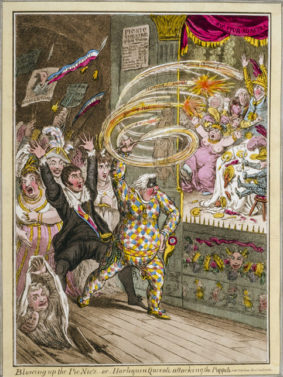Picnic, the English phonetic spelling of pique-nique, owes its introduction in English parlance to the Pic Nics, a London club that had a brief run from 1801-1803.
We remember the Pic Nics because James Gillray lampooned and mocked them. We recognize that this was the period of Romanticism and Wordsworth’s and Coleridge’s poetry, but forget that the Pic Nics were a London scandal, mainly because of the lavish “picnic dinners” served, allusions to which began appearing in juvenile literature three years after the club folded. First appearing was The Courtship, Marriage, and Pic-Nic Dinner of Cock Robin and Jenny Wren. To Which Is Added, Alas! The Doleful Death of the Bridegroom (1806), followed by The Mice and Their Pic Nic. A Good Moral Tale (1809). [Both are discussed elsewhere in Picnic.Wit.com.]
High society knew that the club took the name Pic Nic after the Parisian custom of dining en pique-nique or sharing the cost of their dinners and other expenses. But no one was sure of the etymology. A doggerel poem in their journal Pic Nic takes a satiric jab at a definition:
Philosophers in vain their brains do twist,
To find the derivation of Pic Nic.
And most of them, I think, the truth have mist,
Because their brains were dull, or skulls were thick.
(It’s now known that the word appears abruptly in a Parisian satire published in 1649.)
Pic Nics kept the dining essentials and sponsored amateur theatrical performances and entertainment, a euphemism for gambling (which was illegal). Members advertised themselves as “fashionables,” others derisively labeled them Dilettanti.* At the time, there was a rickety truce in the British and French war, and the Pic Nics tried their luck at being trendy without consequence. They lost the wager,
There were other amateur theatrical groups, notably Lady Elizabeth Craven’s, but she escaped conflict. Pic Nics were attacked because William Brinsley Sheridan, principal of the Drury Lane Theater, particularly perceived them as a drain on the professional theater and mounted a dirty-tricks attack in the London press that claimed they were godless, devilish, and sexually licentious (—all true after a fashion, except for Sheridan’s malicious personal reasons for attacking them). Sniffing the scandal, James Gillray’s savage caricatures opened the Pic Nics to withering ridicule. In addition to Blowing up the Pic Nic’s; – or – Harlequin Quixote attacking the Puppets. Vide Tottenham Street Pantomime (April 2, 1802), The Pic Nic Orchestra (1802), and Dilettanti; or-a-Peep at the Green Room. Vide Pic Nic Orgies (February 1803). The last caricature appeared shortly after the society disbanded.

In motley, William Sheridan, aka Harlequin Quixote, leads an attack on the Pic Nics.
A letter to William Coombe, the editor of the Pic Nic journal, probably his own, summed up their situation:
“Dear Pic,
I am off.—I cannot stand your cloudy atmosphere or the abominable life you all lead. I am hurrying away to Bologna Sausages, Macaroni Sardinias [in the Sardinian style], Garlic, and Oil, with a cloudless sun, and the liberty of doing what I like, without being quizzed by the wits, or lampooned by the newspapers.”
The Pic Nics attracted three kinds of people, dedicated gamblers, amateur actors or dilettanti, and epicure diners. Its subscription list was exclusive and culled from those known as “fashionables” or “people of the first rank, leaders of fashion, or the professional theater.” (Professional actors, singers, and musicians were necessary to bolster the quality of productions.) An evening’s gathering might include dukes, duchesses, and earls; the Prince of Wales (gambler and gourmand), Lady Albina Hobart, Countess of Buckinghamshire (amateur actress, obsessive gambler, and gargantuan eater), and the Duchess of Devonshire (compulsive gambler). The managing director was Lt. Col. Henry Francis Greville, a social entrepreneur, and gambler.
At their peak, there were about 230 Pic Nics, though not all were active. Participation was expensive; their motto was “Excess.” The ante for a meeting was the equivalent of $1000, a portion of the meal, and six bottles of wine. Still, underwriters needed to cover expenses. Food was prepared or purchased elsewhere and assembled at a trendy catering hall. It was served in the French style. What each brought to the table was decided by lot, drawn from a hat. According to the fencing master Henry Angelo, an original Pic Nic, the process was dicey; while some might get off cheaply with China oranges [really from Portugal] or a pound cake, others might need to arrange for pâté de foie gras or very expensive Perigord Pie (made with truffles and game). Besides the wine, diners were provided with champagne, liqueurs, and other beverages.
*The Society of Dilettanti, a drinking and eating club, was founded in 1732. Gillray lampooned them, too.
Featured Image: Theatricals preparing for an evening’s performance. Lord Cholmondeley, dressed as Cupid, is in yellow; Lady Buckinghamshire is the obese woman in white; the Earl of Mount-Edgecombe is the small man in the dragon hat; Col. Greville is in the rear holding a triangle, and Lady Salisbury adjusting her boot alludes to Hogarth’s Rake’s Progress. The Prince of Wales, seen under Buckinghamshire’s red and white feather, stands with his two mistresses.
See William Combe, ed. The Pic Nic. London: 1803; Thomas Wright and R.H. Evans. Historical and Descriptive Account of the Caricatures of James Gillray: Comprising a Political and Humorous History of the Latter Part of the Reign of George the Third London: Henry G. Bohn, 1851; James Gillray, James. The Works of James Gillray, the Caricaturist. Edited by Joseph Grego. London: Chatto & Windus, 1873; Henry Angelo. Reminiscences of Henry Angelo. London: H. Colburn and R. Bentley, 1830; Sybil Rosenfeld. Temples of Thespis. London: Society for Theatre Research, 1978.
